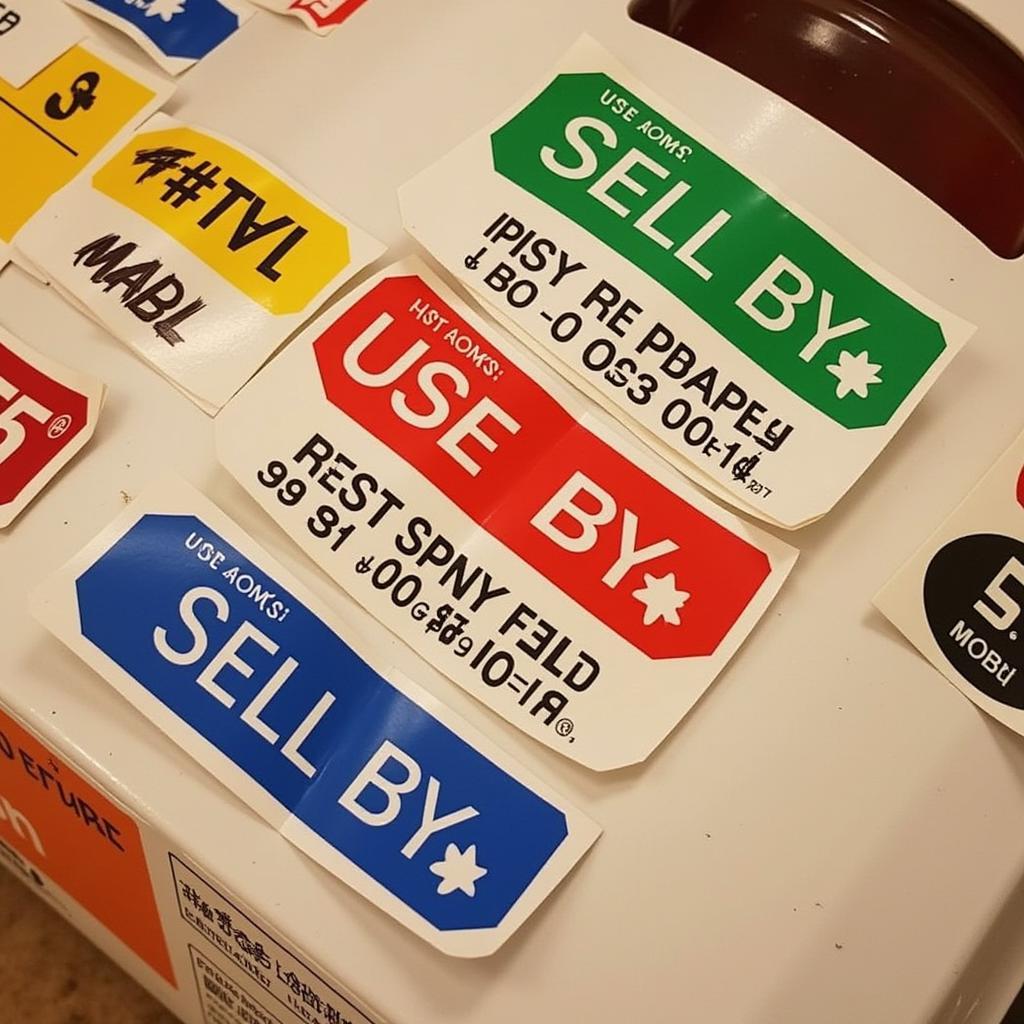Food Date Stickers. Those cryptic codes that grace our groceries, often leaving us scratching our heads in confusion. Are they expiration dates? Sell-by dates? A suggestion box for the grocery gods? Fear not, fellow food lovers, for I’m here to demystify the language of food date stickers and empower you to make informed decisions about your pantry.
The Mystery of Multiple Dates
Let’s face it, navigating the world of food date stickers can feel like cracking the Enigma code. One minute you’re staring at a “best by” date, the next it’s a “use by,” and just when you think you’ve got it figured out, BAM!—”sell by.”
But fret not, these dates aren’t arbitrary numbers designed to send you into a spiral of existential dread. They serve a purpose, albeit a somewhat muddled one.
- “Sell by”: Think of this as a message from the manufacturer to the grocery store. It indicates the last day the product should be displayed for sale, ensuring it spends its prime time on the shelves.
- “Best by/before”: This date signifies when the food is at its peak flavor and quality. It’s not an expiration date, but rather a benchmark for optimal enjoyment.
- “Use by”: Now this one’s a bit more serious. The “use by” date refers to when the product is likely to start deteriorating in terms of quality and safety.
 Variety of Food Date Stickers on Products
Variety of Food Date Stickers on Products
Separating Myth from Reality: Food Date Sticker Fallacies
Despite their prevalence, a lot of misinformation surrounds food date stickers. Let’s debunk some common myths:
-
Myth: Food past its date is automatically unsafe to eat.
Reality: Not necessarily! While “use by” dates should be taken seriously, especially for perishable items, other dates are more about quality than safety. -
Myth: Food date stickers are federally regulated.
Reality: Surprise! Except for infant formula, the dating of food products is largely unregulated at the federal level in the US.
 Checking Milk Freshness
Checking Milk Freshness
Trust Your Senses: The Ultimate Guide to Food Freshness
Remember, food date stickers are just one piece of the puzzle. Your senses are your greatest allies when determining freshness.
- Sight: Is the color off? Are there any signs of mold or unusual textures?
- Smell: Does it smell rancid, sour, or just plain “off”?
- Touch: Is the texture slimy, mushy, or dried out when it should be otherwise?
If something looks, smells, or feels wrong, it’s always best to err on the side of caution and toss it out.
Minimizing Waste, Maximizing Flavor
Here are a few practical tips for navigating the world of food date stickers and reducing food waste:
- FIFO: Embrace the power of “First In, First Out.” Rotate your food containers for take out and pantry items, ensuring older items are used first.
- Freezing for the Win: Extend the life of perishable foods by freezing them before their peak freshness wanes.
- Composting: Give back to the environment by composting food scraps and expired produce.
 Organized Refrigerator with Fresh Produce
Organized Refrigerator with Fresh Produce
Food Date Stickers: Your Guide to a Delicious and Safe Culinary Journey
Understanding food date stickers doesn’t have to be a culinary conundrum. By arming yourself with the knowledge to decipher these codes, you can shop smarter, reduce waste, and savor the full flavor of your favorite foods.
Remember, while date stickers provide helpful guidelines, your senses are your ultimate guide. So, trust your gut (not literally, of course!), and enjoy the delicious journey of culinary exploration!
FAQ
1. What does “packed on” mean on food labels?
“Packed on” usually refers to the date a product was packaged or processed, not necessarily the date it was harvested or produced. It can be helpful in determining the freshness of non-perishable items.
2. Can I eat yogurt a few days after the “sell-by” date?
Yogurt, like many dairy products, often remains safe to consume several days past the “sell-by” date if stored properly. However, always use your senses to check for any signs of spoilage.
3. Are expiration dates on eggs accurate?
Eggs typically remain fresh for several weeks past the printed expiration date when stored properly in the refrigerator. To test for freshness, try the float test: An egg that sinks to the bottom of a bowl of cold water is fresh, while an egg that floats is older and should be used with caution.
4. What about “best by” dates on spices?
Spices don’t truly “expire,” but they do lose potency over time. While still safe to consume past their “best by” date, their flavor and aroma may be diminished.
5. How can I learn more about specific food storage guidelines?
For detailed information on safe food handling and storage practices, refer to resources from reputable organizations like the USDA (United States Department of Agriculture) or the FDA (Food and Drug Administration).
Need more information?
For more insights on food storage and packaging solutions, check out our related articles:
- Food clamshell packaging: Learn about sustainable and convenient options for your takeout needs.
- Plastic containers for take out food: Explore a variety of durable and practical containers to keep your meals fresh.
Have questions or need assistance? Don’t hesitate to contact us! You can reach us at 02437655121, email us at [email protected], or visit our office at 3PGH+8R9, ĐT70A, thôn Trung, Bắc Từ Liêm, Hà Nội, Việt Nam. Our dedicated customer support team is available 24/7 to assist you.